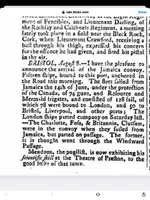Page 92,
https://www.bristol.ac.uk/Depts/History/bristolrecordsociety/publications/brs20.pdf
I6 Oct I795 In the Britannia, George Clutsam, master, from
Jamaica
Protheroe & Claxton, 3I7 hogsheads 50 tierces sugar, I5 puncheon
rum, 28 tons logwood
L. & R. Bright,4 45 hogsheads sugar, 3 puncheon rum, I7 tierces
coffee
Munckley & Co. 35 hogsheads sugar John Fisher Weare,s 54 hogsheads
sugar
John Maxse,6 20 hogsheads sugar, IO puncheon rum
W. Fuss,7 3 hogsheads sugar, 5 puncheon rum
Milligan & Mitchell, 20 hogsheads sugar W. Da vis, s 2 hogsheads
sugar
W. Pownall, 9 I barrel sugar Mrs. Lane, I barrel sugar




 ]https://tamu.libguides.com/c.php?g=461106&p=3152733[/url]
]https://tamu.libguides.com/c.php?g=461106&p=3152733[/url] So how many days at sea before she wrecked, and a general average of the sailing performance/speed should put us in a certain area if we also know the direction she was headed !!
So how many days at sea before she wrecked, and a general average of the sailing performance/speed should put us in a certain area if we also know the direction she was headed !!
